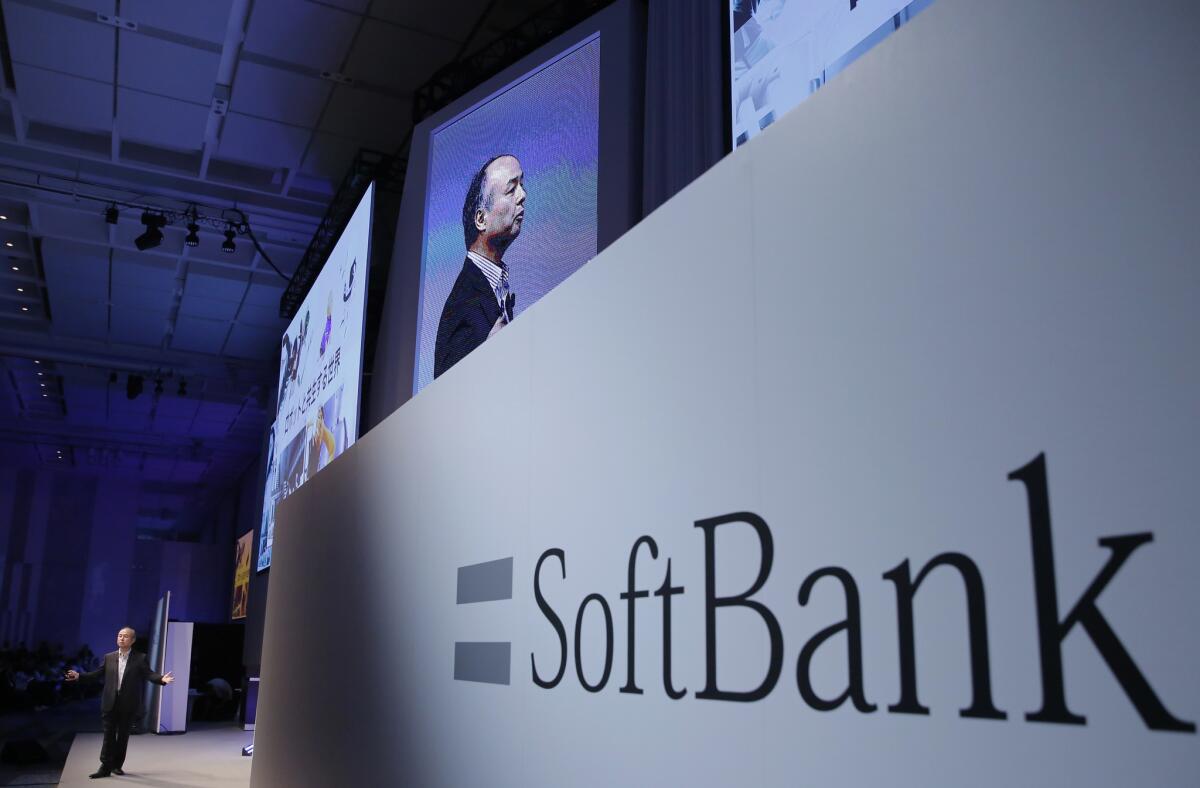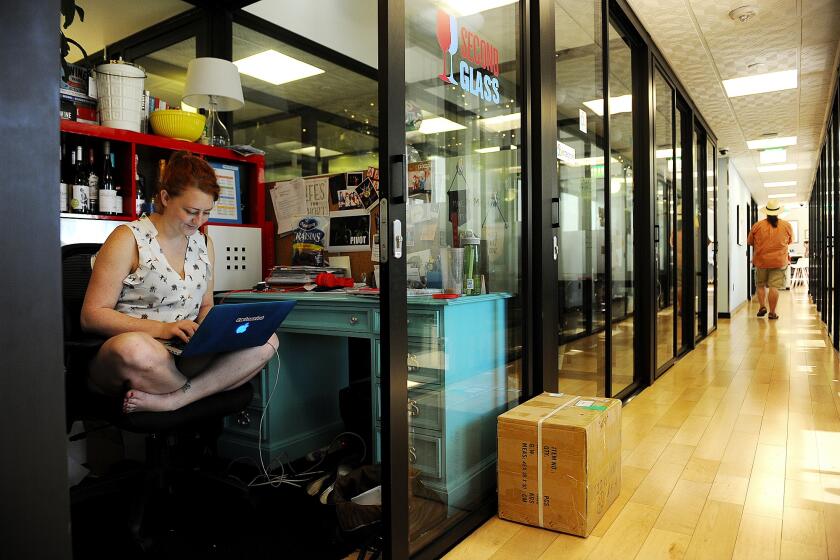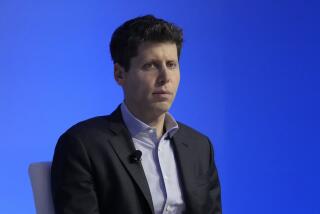At SoftBank, blind spots threaten Masayoshi Son’s $100-billion Vision Fund

- Share via
One year ago, the global business elite deserted a Saudi Arabian investment summit in droves after the killing of journalist Jamal Khashoggi by Saudi agents. But the founder of Japan’s SoftBank slipped into Riyadh for a discreet meeting.
Masayoshi Son and his chief lieutenant, Rajeev Misra, were there to see Mohammed bin Salman, the crown prince who had helped to make them the world’s most influential technology investors. Almost half of SoftBank’s $97-billion technology-focused Vision Fund — the biggest pool of private money ever raised — came from the young royal’s sovereign wealth fund.
Their message for Prince Mohammed was clear: SoftBank, they said, would not abandon him, people briefed on the conversation told the Financial Times. The crown prince pledged never to forget their loyalty.
One year later the strength of those bonds is being tested and plans for a long-awaited sequel to the Vision Fund are in serious doubt.
For founders like WeWork’s Adam Neumann, gargantuan funding offered an opportunity — or an imperative — to double down on unproven and money-losing business models.
Armed with Persian Gulf capital, SoftBank poured into every corner of the digital economy and fueled some of the world’s most richly valued private companies. Following Son’s advice, many burned cash in feverish pursuit of scale and market share above all else.
But the near-collapse of SoftBank’s biggest gamble, co-working group WeWork, and the plummeting valuation of its other holdings have dramatically shaken faith in Son’s investment genius and his bets on disruptive technology.
If the troubles at SoftBank and its Vision Fund escalate into a crisis, as some fear, it would resonate from Silicon Valley, Beijing and Mumbai, India, to the financial centers of London, Wall Street and Tokyo.
Returning to Riyadh in late October for the latest Future Investment Initiative, known as Davos in the Desert, Son was met by an almost-empty room for his panel discussion. The weary-looking billionaire, who at one point appeared to fall asleep, insisted he would keep offering capital to start-ups so they could “grow much bigger and quicker.”
“We identify the entrepreneurs who have the greatest vision to solve the unsolvable,” he said. “They need to have the strongest passion. And then we provide the cash to fight.”
The downfall of WeWork, rebranded as We Co., has been a humbling experience. “It’s been embarrassing for him,” said a person who works closely with Son. “He has to rethink his approach.”
SoftBank shares have plummeted more than 25% in the last three months. On Wednesday, the company reported a $6.5-billion quarterly loss and wrote down the value of several investments. That included a $4.6-billion charge for WeWork.
The struggles have laid bare a sharp-elbowed culture within the Vision Fund, which is led by Misra and seen as rife with mistrust, managerial disorganization and clashes between executives.
Despite efforts at scaling and maturing its investment arm, SoftBank has been unable to shake off a “Wild West” culture at the London-based fund, where power struggles have contributed to high-level departures, including that of Mark Schwartz, the company’s longtime independent director.
Around 50 cars with Uber and Lyft logos plastered on their windshields wound through the palm tree-lined streets of Beverly Hills, down Rodeo Drive and into the quiet hills, past palatial homes.
Ride-hailing firm Uber’s May 10 initial public offering of stock was supposed to be a coming-of-age moment for a Silicon Valley “unicorn.” Instead, it turned into a rude awakening about the public market’s attitude toward loss-making start-ups, which the Vision Fund had loaded up on.
Uber is now down about 30% from its listing price, with the Vision Fund sitting on more than $800 million in paper losses. Other investments have suffered too: Office messaging group Slack has dropped nearly 45% since its first day of trading in June, and Vir Biotechnology has fallen 30% since its mid-October listing. Only two Vision Fund-backed companies, Guardant Health and 10X Genomics, are trading above their IPO price.
“If SoftBank says this is the value, how much of that should you believe?” said Kirk Boodry, a tech analyst at Redex Holdings who publishes on research platform Smartkarma. One hedge fund investor said backing from the Vision Fund is “an immediate cue to sell.”
The steady procession of IPOs was intended to validate the Vision Fund’s late-stage bets and lay the groundwork for juicy returns that would make big-money investors clamor to pour money into its next Vision Fund. The group would look to list at least two portfolio companies per month by 2020, Misra said earlier this year.
Suddenly, with the wisdom of that model in question, support from the rest of the market is not a given.
The biggest blow, however, came from a company whose founder Son has praised and lavished with billions of dollars since 2017, saying it would be worth a few hundred billion one day.
The close bond between Son and WeWork founder Adam Neumann had begun to sour long before the disastrous attempt to list in September. The turning point came late last year.
Teams from SoftBank and WeWork had been toiling in secret since Thanksgiving on an audacious plan they called Project Fortitude, which would have seen SoftBank and the fund buying out every WeWork shareholder except Neumann for $10 billion and injecting a total of $10 billion into the company.
As the negotiators broke up for the Christmas holidays, however, Son called Neumann to say they would have to rethink: The Vision Fund had backed out, and with SoftBank’s own shares falling he would ultimately commit just $2 billion of additional capital in January. In theory, the new deal pumped WeWork’s valuation up to $47 billion. But the company’s rapid cash burn meant it would need to hasten plans for an IPO.
Months later WeWork ditched its IPO plans after failing to fetch even a $15-billion valuation from investors. The shelved IPO led to a $9.5-billion rescue package from SoftBank to save the business. The deal valued WeWork at just $8 billion, although Neumann, whose special voting rights gave him the leverage, negotiated a controversial $1.7-billion exit package even as 4,000 WeWork employees are to be fired.
“We created a monster,” Son has told colleagues. “We gave him all the capital.”
Few things prove the ancient warning “Be careful what you wish for” like a Wall Street sure thing that blows itself to smithereens.
There are concerns about other privately held companies in the Vision Fund portfolio. One company that has raised eyebrows is India’s Oyo, in which the Vision Fund owns a 50% stake. The hotel chain’s most recent $2-billion investment round was led by Ritesh Agarwal, Oyo’s 25-year-old founder, in an unusual deal that doubled its valuation to $10 billion and saw him tap into loans from Japanese banks with close ties to SoftBank.
Concerns about passenger safety at Didi Chuxing, China’s answer to Uber, have held back its growth in the last year. Other bets are not expected to generate any returns. Fair, the car subscription start-up that partners with Uber, recently revealed plans to cut 40% of its workforce as it struggles to become profitable. Wag, the dog-walking company backed by a $300-million Vision Fund check, has been earmarked for sale.
“Money in the right hands, right founders and right potential long-term platforms works,” said Nikesh Arora, Son’s former heir apparent, who abruptly resigned in 2016, at a recent CNBC event. “But it doesn’t work willy-nilly on every pet-walking and hotel room-renting website.”
It is hard to formulate a cohesive picture of SoftBank and the Vision Fund, in part because of Son’s incessant deal-making, and also because of the extreme levels of financial engineering employed by Misra.
“SoftBank and the Vision Fund are layers of leverage upon leverage,” said one banker who has worked closely with both.
SoftBank is saddled with $160 billion of interest-bearing debt and its bonds are rated non-investment grade. The Vision Fund has a unique structure — created by Misra — in which roughly $40 billion of outside investor funds are in the form of preferred shares that work like debt and pay an annual coupon.
When Misra looked to return capital to the Vision Fund’s backers earlier this year, he added yet more leverage, taking out a $3.5-billion loan mortgaged against stakes in companies including Uber.
Under Misra’s watch, the fund’s ranks have grown to more than 400 employees, while it tries to shed its unruly image. It has tightened control functions in areas such as compliance, accounting and legal.
Nothing about WeWork looks normal, and Wall Street may finally be waking up
A second Vision Fund would help Son silence his critics. A rollout this summer of those plans was designed to showcase SoftBank’s ability to attract blue-chip investors such as Microsoft. But no outside investors have formally signed up yet for the $108-billion fundraising.
Executives within and close to SoftBank concede that renewed commitments from Saudi Arabia and its neighbor Abu Dhabi are crucial if there is to be a second fund. Both have been slow to commit, even as SoftBank executives are counting on Prince Mohammed to invest up to $30 billion with them.
“I don’t see how you could do it without them,” said one person involved.
Advisors to the crown prince have urged him to reduce his exposure to SoftBank. But he is said to want to honor his promise to Son.
© The Financial Times Ltd. 2019. All rights reserved. FT and Financial Times are trademarks of the Financial Times Ltd. Not to be redistributed, copied or modified in any way.
More to Read
Inside the business of entertainment
The Wide Shot brings you news, analysis and insights on everything from streaming wars to production — and what it all means for the future.
You may occasionally receive promotional content from the Los Angeles Times.














